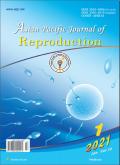桃通过调节大鼠睾丸组织StAR和3β-HSD的表达来增加睾酮的生物合成
IF 0.6
Q4 REPRODUCTIVE BIOLOGY
引用次数: 1
摘要
目的:评价桃籽甲醇提取物和甲醇提取物乙酸乙酯部分对睾酮生物合成的影响,并阐明其潜在机制。方法:48只雄性Wistar大鼠分为8组(每组6只)。第一组口服0.3%w/w阿拉伯树胶混悬液,作为正常对照组。第二组为阳性对照组,于蛛网膜下腔注射丙酸睾酮。第III组至第V组以50、100和200毫克/公斤体重的剂量口服波斯芽孢杆菌甲醇提取物。第VI至VIII组以50mg/kg、100mg/kg和200mg/kg体重的剂量口服施用B.persica乙酸乙酯部分。睾丸用于生化评估和组织学研究。在睾丸组织和精子浓度中,评价了柿子甲醇提取物和乙酸乙酯部分对睾丸睾酮、甾体生成急性调节蛋白(StAR)和3β-羟基类固醇脱氢酶(3β-HSD)mRNA表达以及3β-HSD酶测定的影响。用柱色谱法测定了波斯B.persica的乙酸乙酯部分。使用TM3细胞系在三个剂量水平(50、100、200μg/mL)下进行体外研究,分别针对甲醇提取物、乙酸乙酯部分和2-苯并恶唑啉酮,以评估其对睾酮产生的比较影响。结果:与正常对照组相比,柿子乙酸乙酯组分和甲醇提取物可提高睾丸睾酮含量。用B.persica的甲醇提取物和乙酸乙酯部分处理后,StAR对应的mRNA表达分别增加了6.7倍和10.6倍,而3β-HSD的mRNA表达则分别增加了5.7倍和7.3倍。此外,组分和提取物处理显示睾丸组织中3β-HSD活性增加,并发现提高精液中精子浓度。组织学观察进一步确保了生精潜能。2-苯并恶唑啉酮从乙酸乙酯馏分中分离,并通过光谱研究进行鉴定。它显示出增加TM3 Leydig细胞中睾酮含量的能力。结论:柿子甲醇提取物和乙酸乙酯组分能够通过提高睾丸组织StAR和3β-HSD的mRNA表达来增加大鼠睾丸睾酮,从而提高精子浓度。本文章由计算机程序翻译,如有差异,请以英文原文为准。
Blepharis persica increases testosterone biosynthesis by modulating StAR and 3β-HSD expression in rat testicular tissues
Objective: To evaluate the effect of methanolic extract and ethyl acetate fraction of methanol extract prepared from the seeds of Blepharis (B.) persica on testosterone biosynthesis and also to elucidate the underlying mechanism. Methods: Forty-eight male Wistar rats were divided into eight groups (n=6 per group). Group I received 0.3% w/w gum acacia suspension p.o. and served as the normal control group. Group II was administered testosterone propionate in arachis oil i.m. as the positive control group. Group III to V received B. persica methanolic extract p.o. at doses of 50, 100 and 200 mg/kg body weight. Group VI to VIII received B. persica ethyl acetate fraction p.o. at doses of 50, 100 and 200 mg/kg body weight. The testis was used for biochemical estimation and histological studies. The effects of methanolic extract and ethyl acetate fraction of B. persica on testicular testosterone, mRNA expression corresponding to steroidogenic acute regulatory protein (StAR) and 3β-hydroxysteroid dehydrogenase (3β-HSD) along with 3β-HSD enzyme assay were evaluated in testicular tissues and sperm concentration. Ethyl acetate fraction of B. persica was subjected to column chromatography. In-vitro studies were performed using TM3 cell line at three dose levels (50, 100, 200 μg/mL), each for methanolic extract, ethyl acetate fraction and 2-benzoxazolinone for evaluation of their comparative effect on testosterone production. Results: Ethyl acetate fraction and methanolic extract of B. persica could elevate the testicular testosterone content compared to the normal control group. The treatment with methanolic extract and ethyl acetate fraction of B. persica increased the expression of mRNA corresponding to StAR by 6.7 fold and 10.6 fold, respectively, whereas the mRNA expression of 3β-HSD increased by 5.7 fold and 7.3 fold, respectively. Moreover, fraction and extract treatment exhibited increased 3β-HSD activity in the testicular tissues and were found to elevate sperm concentration in seminal fluid. The spermatogenic potential was further ensured by histological observations. 2-benzoxazolinone was isolated from ethyl acetate fraction and identified using spectral studies. It showed the ability to increase the testosterone content in the TM3 Leydig cells. Conclusions: Methanolic extract and ethyl acetate fraction of B. persica are able to increase the testicular testosterone in rats by elevating mRNA expression of StAR and 3β-HSD in testicular tissues, leading to increase the sperm concentration.
求助全文
通过发布文献求助,成功后即可免费获取论文全文。
去求助
来源期刊

Asian Pacific Journal of Reproduction
Veterinary-Veterinary (all)
CiteScore
1.70
自引率
0.00%
发文量
588
审稿时长
9 weeks
期刊介绍:
The journal will cover technical and clinical studies related to health, ethical and social issues in field of Gynecology and Obstetrics. Articles with clinical interest and implications will be given preference.
 求助内容:
求助内容: 应助结果提醒方式:
应助结果提醒方式:


